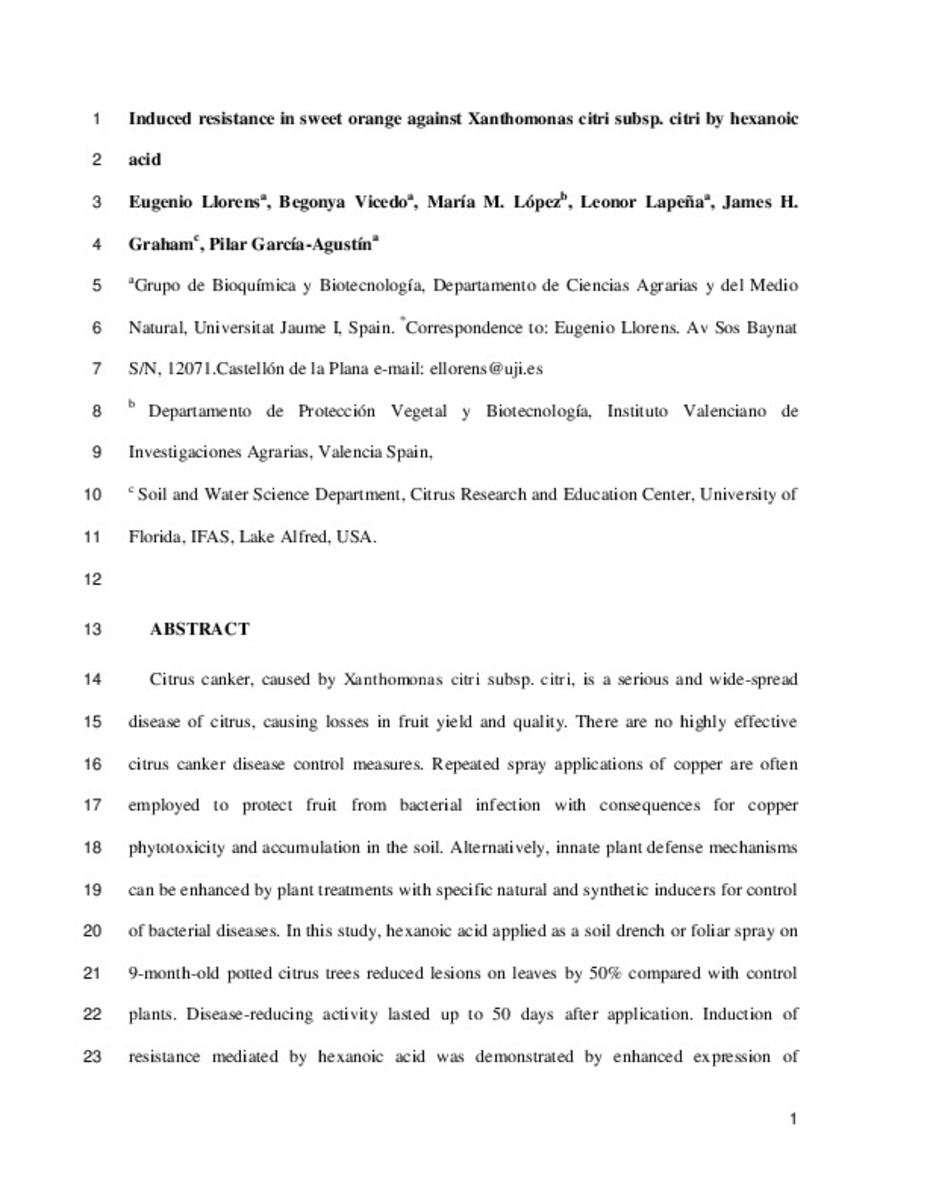Mostrar el registro sencillo del ítem
Induced resistance in sweet orange against Xanthomonas citri subsp. citri by hexanoic acid
| dc.contributor.author | Llorens, Eugenio | |
| dc.contributor.author | Vicedo, Begonya | |
| dc.contributor.author | López, María M. | |
| dc.contributor.author | Lapeña, Leonor | |
| dc.contributor.author | Graham, James H. | |
| dc.contributor.author | García Agustín, Pilar | |
| dc.date.accessioned | 2016-05-27T15:08:50Z | |
| dc.date.available | 2016-05-27T15:08:50Z | |
| dc.date.issued | 2015-08 | |
| dc.identifier.citation | Llorens, E., Vicedo, B., López, M. M., Lapeña, L., Graham, J. H., & García-Agustín, P. (2015). Induced resistance in sweet orange against Xanthomonas citri subsp. citri by hexanoic acid. Crop Protection, 74, 77-84. | ca_CA |
| dc.identifier.issn | 0261-2194 | |
| dc.identifier.uri | http://hdl.handle.net/10234/160057 | |
| dc.description.abstract | Citrus canker, caused by Xanthomonas citri subsp. citri, is a serious and wide-spread disease of citrus, causing losses in fruit yield and quality. There are no highly effective citrus canker disease control measures. Repeated spray applications of copper are often employed to protect fruit from bacterial infection with consequences for copper phytotoxicity and accumulation in the soil. Alternatively, innate plant defense mechanisms can be enhanced by plant treatments with specific natural and synthetic inducers for control of bacterial diseases. In this study, hexanoic acid applied as a soil drench or foliar spray on 9-month-old potted citrus trees reduced lesions on leaves by 50% compared with control plants. Disease-reducing activity lasted up to 50 days after application. Induction of resistance mediated by hexanoic acid was demonstrated by enhanced expression of Pathogenesis-related (PR) genes and callose deposition in treated and infected plants. These findings indicated that hexanoic acid applications trigger a defensive response in the plants. The application of this natural compound may have potential for management of citrus canker in conjunction with other disease control measures and may reduce the frequency or rate of copper bactericides. | ca_CA |
| dc.description.sponsorShip | This work has been supported by the “Programa de mobilitat del personal investigador” of the Fundació Caixa Castelló-Bancaixa, the Spanish National R&D Plan (AGL2010-22300-C03-01 and AGL2010-22300-C03-02) and Prometeo2012/066. The authors are grateful to the IVIA and CREC. | ca_CA |
| dc.format.extent | 8 p. | ca_CA |
| dc.format.mimetype | application/pdf | ca_CA |
| dc.language.iso | spa | ca_CA |
| dc.publisher | Elsevier | ca_CA |
| dc.relation.isPartOf | Crop Protection, 2015, vol. 74 | ca_CA |
| dc.rights | © 2015 Elsevier Ltd. All rights reserved. | ca_CA |
| dc.rights.uri | http://rightsstatements.org/vocab/InC/1.0/ | * |
| dc.subject | Hexanoic acid | ca_CA |
| dc.subject | Citrus | ca_CA |
| dc.subject | Xanthomonas citri | ca_CA |
| dc.subject | Induced resistance | ca_CA |
| dc.title | Induced resistance in sweet orange against Xanthomonas citri subsp. citri by hexanoic acid | ca_CA |
| dc.type | info:eu-repo/semantics/article | ca_CA |
| dc.identifier.doi | http://dx.doi.org/10.1016/j.cropro.2015.04.008 | |
| dc.rights.accessRights | info:eu-repo/semantics/openAccess | ca_CA |
| dc.relation.publisherVersion | http://www.sciencedirect.com/science/article/pii/S0261219415300107 | ca_CA |
Ficheros en el ítem
Este ítem aparece en la(s) siguiente(s) colección(ones)
-
CAMN_Articles [566]







